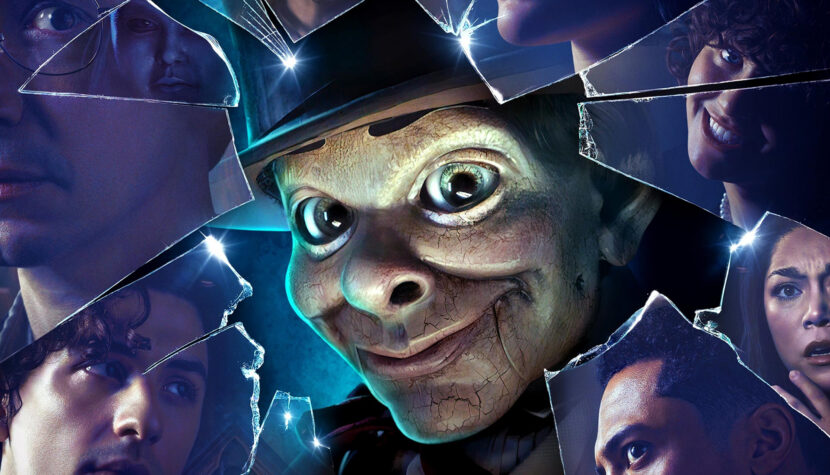GOOSEBUMPS. Demons versus Teen Problems [REVIEW]

October is the month of preparing for Halloween, while December is marked by Santa Claus and Christmas. Cultures blend, some holidays fade into oblivion, others become more widespread, evident in stores, media, and even street decorations. In streaming services, ghosts and monsters begin to dominate more than a month ago. After November 1st, the stylistic theme will change again. Currently, on Disney+, another series about supernatural phenomena has premiered, titled after two very popular full-length films and also a 90s series – Goosebumps. All these productions are more or less faithful adaptations of R.L. Stine’s book series, often called the Stephen King of children’s and young adult literature. Is this return to the series format successful and necessary, or would another full-length installment be better?
The advantage of the full-length Goosebumps parts was primarily the energetic realization of substantial stories written according to standard and proven principles of combining horror with adventure cinema. In the 2015 production, the film was additionally driven by the comedic Jack Black in the role of the dark author of animated novels (Stine), also lending his voice to the series’ characteristic antagonist named Slappy. In the 2018 production, Jack Black’s presence was significantly reduced, but the spotlight was given to young actors and, like before, to Slappy, who “made the whole movie.” Moreover, Halloween was vividly depicted with its comedic-horror atmosphere. Although these were undoubtedly productions for younger viewers, parents could certainly enjoy them with their children. The personal adventures of the characters were narrowed down to typical adventure action.
The latest production has revolutionized these principles. Currently, there are 5 episodes available on the Disney+ platform, with the next 5 appearing every Friday. The plot also revolves around Halloween, or rather, what follows this holiday. The story unfolds much more slowly than in full-length productions, with fewer elements of horror and typical action. Instead, very mundane sequences replaced them, allowing us to get to know the characters from the perspective of their emotions and relationships with other peers in a classic small American town and a typical American school, where a lot happens by the lockers in the corridor, as is common in teen movies. Unfortunately, there are no standout characters, whether child or adult, and the monsters also lack a clearly defined personality. Harold appears most frequently, but it’s hard to guess who he is, what his motivations are, etc. He is a somewhat one-dimensional antagonist.

One must ask – who is this show targeted at? On the one hand, it is not a mature show for adults, and on the other hand, teenagers are treated very maturely, including sexual themes, which is not unusual for today’s teenagers but might be for younger children. For parents, the latest Goosebumps might seem both infantile and overly mature. So, who is it for? Certainly not for younger children who would like to enjoy an adventure session with their parents. Not for parents either, as the characters in the series are still too young and, in places, too artificially portray adulthood. Perhaps for teenagers? Maybe for American teenagers, although not all of them. However, I doubt it’s for European teenagers who may find that the series too blatantly combines overly complicated, adult problems of youth with incredibly childish behaviors, as well as formally with horror elements. Everything clashes because there are so many endless analyses, conversations, and adventures that there’s no room for typical action, which one would expect from a series based on the Goosebumps series. Thus, the demons lose out when school, lessons, breakfast at home, meetings with friends, parties, and first infatuations appear. This happens both in the narrative perspective and unfortunately in the aesthetic, formal one. Horror elements are present in every episode, but they don’t really give you goosebumps, except perhaps for the episode with the multiplied James. There is also no sense that the series is heading towards a climactic point. It’s consistently average, lacking flair, somewhat boring, but not entirely enough to definitively give up watching. On the other hand, there’s nothing that truly amazes and makes you eagerly await the next Friday and a new episode.

October is the month of Halloween, full of spiritual, supernatural tension experienced with a wink, somewhat macabre and parody-like. We familiarize the younger ones with what is inevitable, with demonic and historical elements of our folk culture, so that their tolerance horizon is broader. We also familiarize ourselves because openness to otherness, including the monstrous kind, unfortunately diminishes if not practiced. And in this regard, within the entire month of anticipating that one evening of spirits on the 31st, the series fulfills its purpose. However, as an entertainment production regardless of the holiday theme, compensating for narrative shortcomings with its atmosphere, it loses and won’t be revisited like full-length Goosebumps movies. There’s another crucial element missing in the production – comedic elements were practically abandoned. No character remains with comedic talent, like Jack Black. And remember, Halloween is a holiday of pranks, laughter, dressing up, creating a unique atmosphere, a world in which you can have fun with everything that causes unspeakable fear.
So, answering the initial question, whether it would be better to make a third full-length movie, we have clarity. Unfortunately, the potential of the story was wasted, although on that one night of death reconciliation, I won’t discourage anyone from watching. The series is not a total failure, and even if it were, there would still be fans.

